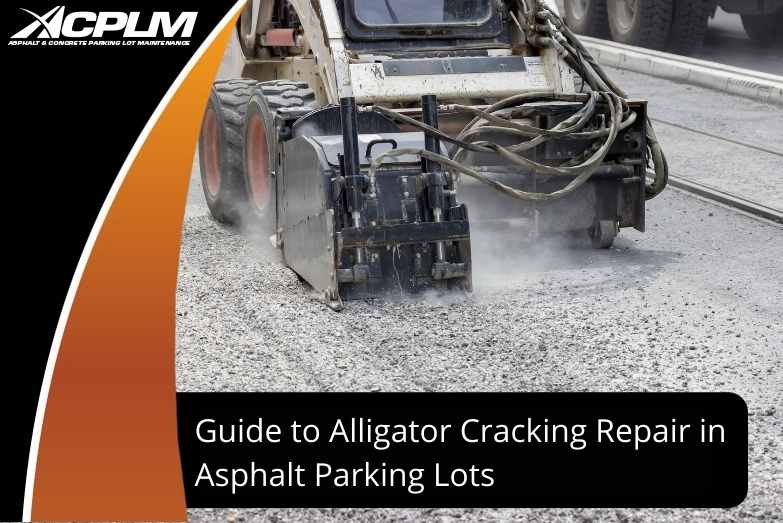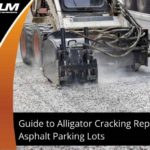
Everything You Need to Know About Alligator Asphalt Cracking and Repair in Tampa, FL.
If you see interconnected cracks that resemble the pattern of alligator skin on your Tampa parking lot, you’re likely dealing with alligator cracking, also called fatigue cracking, and it needs to be repaired quickly.
Alligator asphalt cracking is a sign of deeper structural issues beneath the pavement’s surface, and if left untreated, it can lead to major damage, potholes, and costly reconstruction.
The only long-term fix for alligator asphalt cracking repair in Tampa is to identify and treat the root cause, usually issues with the base layer beneath the asphalt. While temporary crack fillers or patching may help in the short term, true repair involves excavating damaged sections and rebuilding the foundation for long-lasting results.
Key Insights
- Alligator cracks indicate structural weakness in the pavement’s base layer.
- Temporary repairs like crack filling may slow deterioration but are not permanent fixes.
- Permanent repairs require excavation and reconstruction of the affected area.
- Prevention through proper installation, drainage, and maintenance helps reduce the risk.
- Early intervention saves money and prevents accidents, potholes, and liability.
What Are Alligator Cracks?
Alligator cracks, also known as fatigue cracking, form when the base of your asphalt pavement becomes weak or unstable. On the surface, they appear as groups of small, interconnected cracks resembling alligator skin. These types of cracks are common in Tampa parking lots and asphalt surfaces exposed to repeated stress, poor drainage, or aging infrastructure.
Common Causes of Alligator Cracking in Tampa Parking Lots
1. Water Penetration
One of the leading causes of alligator cracking in Tampa is water infiltration. When moisture seeps through surface cracks and into the base layer, it weakens the structural integrity of your asphalt. Over time, this creates soft spots that eventually crack under pressure.
2. Poor Construction or Base Installation
If the asphalt was installed with a weak or improperly compacted base, the pavement will begin to fail prematurely. Substandard materials or poor grading can accelerate the onset of alligator cracks within just a couple of years.
3. Heavy Traffic and Overloading
Parking lots that experience frequent heavy-duty vehicle traffic are at a higher risk for alligator cracking. Trucks, delivery vans, or improperly designed traffic flow can create excessive stress on areas not built to handle the weight.
4. Insufficient Asphalt Thickness
Thinner asphalt layers are less resilient. If your pavement lacks adequate thickness for the level of traffic, it becomes more prone to cracking under pressure.
5. Cold Weather and Temperature Fluctuations
While Tampa isn’t known for harsh winters, cooler temperatures combined with rain can still cause thermal contraction, resulting in cracks and weakened pavement over time.
How to Repair Alligator Cracking in Tampa
Short-Term Repair: Crack Filling
In the earliest stages, crack fillers can help delay further deterioration. Professional crack filling in Tampa can prevent water from seeping into your base layer, buying you some time while planning a long-term solution.
However, crack filling is not a permanent repair for alligator cracks. It’s a temporary fix best suited for hairline or superficial surface cracks.
Medium-Term Repair: Gator Patch Asphalt Repair
Alligator crack filler or gator patch is a thicker material used to cover larger cracked areas. While it looks better and improves surface appearance, this method also doesn’t address the underlying structural issues. It’s only appropriate for mild to moderate cracking and low-traffic areas.
Permanent Repair: Full-Depth Removal and Replacement
For long-lasting results, the best solution is to remove the damaged asphalt and rebuild the base layer before applying new asphalt on top. This process may include:
- Saw-cutting and excavating the cracked area
- Regrading and compacting a new sub-base
- Installing new hot mix asphalt
- Applying sealcoating and striping (if needed)
This method ensures that the cracks will not return and that your parking lot is structurally sound for years to come.
Why Prompt Alligator Crack Repair Matters
Waiting too long to repair alligator cracks in asphalt can lead to:
- Hazardous potholes
- Trip and fall risks for pedestrians
- Vehicle damage and liability issues
- Costly full-lot reconstruction
- Decreased curb appeal and property value
Asphalt damage accelerates rapidly once water reaches the sub-base. What starts as a small alligator crack can evolve into large potholes and dangerous surface failures in a matter of months.
Preventing Alligator Asphalt Cracking in Tampa
While not all cracking can be prevented, you can significantly reduce your risk with proactive parking lot maintenance in Tampa. Here’s how:
Install Asphalt Correctly from the Start
Make sure your contractor uses the proper asphalt thickness and installs a compacted base designed for the type of traffic your property receives.
Maintain Regular Sealcoating
Sealcoating protects your pavement from UV rays, oil spills, and water intrusion. For Tampa properties, it’s generally recommended every 3–5 years.
Invest in Proper Drainage
Ensure water drains away from your pavement. Poor drainage is one of the top contributors to alligatored asphalt.
Restrict Heavy Vehicles
If possible, redirect heavy-duty traffic away from weak or thin pavement areas. Designated truck routes can prevent base failure.
Schedule Routine Inspections
Annual inspections by professionals can help catch small issues before they become major repairs. Cracked asphalt caught early is cheaper and easier to fix.
Is Alligator Cracking the Same as Crocodile Cracking?
The terms alligator cracking and crocodile cracking are used interchangeably in the paving industry. Both refer to the same pattern of interconnected cracks caused by structural fatigue in asphalt surfaces.
FAQs
Can I repair alligator cracks myself?
DIY asphalt patch kits may offer a short-term fix, but professional assessment and repair are essential to truly fix the issue and prevent recurring damage.
How much does alligator crack repair cost in Tampa?
Cost depends on the severity and size of the damaged area. A small patch might be affordable, while large-scale base failure could require full repaving. Early detection keeps costs down.
How long will a repaired area last?
With proper installation and routine maintenance, a repaired section of pavement can last 15–20 years or longer.
Call ACPLM for Alligator Asphalt Cracking Repair in Tampa
If you’ve spotted alligator cracks in your asphalt parking lot, don’t wait. Addressing the problem early prevents costly damage, safety issues, and long-term liability. For expert alligator asphalt cracking repair in Tampa, trust the professionals at ACPLM.
We provide full-service asphalt maintenance, including Tampa crack filling services, asphalt repair, and complete parking lot maintenance. Our experienced team will assess the damage, identify the cause, and recommend the most cost-effective and durable solution.
Call ACPLM today at 888-959-9637 to schedule an inspection or request a free estimate.





